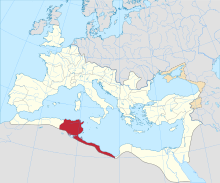
Thunusruma (Tunudruma) was a Roman – Berber civitas (town) in the province of Africa Proconsularis. Its exact location is uncertain, but it must have been somewhere in northern Tunisia.

The Roman Empire was the post-Roman Republic period of the ancient Roman civilization. It had a government headed by emperors and large territorial holdings around the Mediterranean Sea in Europe, North Africa, and West Asia. From the constitutional reforms of Augustus to the military anarchy of the third century, the Empire was a principate ruled from the city of Rome. The Roman Empire was then divided between a Western Roman Empire, based in Milan and later Ravenna, and an Eastern Roman Empire, based in Nicomedia and later Constantinople, and it was ruled by multiple emperors.

Berbers, or Amazighs are an ethnic group of several nations indigenous to North Africa.

In the history of Rome, the Latin term civitas, according to Cicero in the time of the late Roman Republic, was the social body of the cives, or citizens, united by law. It is the law that binds them together, giving them responsibilities (munera) on the one hand and rights of citizenship on the other. The agreement (concilium) has a life of its own, creating a res publica or "public entity", into which individuals are born or accepted, and from which they die or are ejected. The civitas is not just the collective body of all the citizens, it is the contract binding them all together, because each of them is a civis.
In antiquity, the town was also the seat of a Christian diocese, suffragan of the Archdiocese of Carthage. [1]

A cathedra or bishop's throne is the seat of a bishop. It is a symbol of the bishop's teaching authority in the Catholic Church, the Orthodox Church, and the Anglican Communion churches. Cathedra is the Latin word for a chair with armrests, and it appears in early Christian literature in the phrase "cathedrae apostolorum", indicating authority derived directly from the apostles; its Roman connotations of authority reserved for the Emperor were later adopted by bishops after the 4th century. A church into which a bishop's official cathedra is installed is called a cathedral.
Christianity is a religion based on the life and teachings of Jesus of Nazareth, as described in the New Testament. Its adherents, known as Christians, believe that Jesus Christ is the Son of God and savior of all people, whose coming as the Messiah was prophesied in the Old Testament. Depending on the specific denomination of Christianity, practices may include baptism, Eucharist [Holy Communion], prayer, confession, confirmation, burial rites, marriage rites and the religious education of children. Most denominations have ordained clergy and hold regular group worship services.

The word diocese is derived from the Greek term dioikesis (διοίκησις) meaning "administration". Today, when used in an ecclesiastical sense, it refers to the ecclesiastical district under the jurisdiction of a bishop.
Only one bishop of this diocese is known, Ottaviano, who intervened at the Council of Carthage (525). Tunudruma is now a titular bishopric of the Roman Catholic Church [2] and the current bishop is Josef Hrdlička of Olomouc. [3]
A titular bishop in various churches is a bishop who is not in charge of a diocese. By definition, a bishop is an "overseer" of a community of the faithful, so when a priest is ordained a bishop, the tradition of the Roman Catholic and Orthodox churches is that he be ordained for a specific place. There are more bishops than there are functioning dioceses. Therefore, a priest appointed not to head a diocese as its diocesan bishop but to be an auxiliary bishop, a papal diplomat, or an official of the Roman Curia is appointed to a titular see.
A bishop is an ordained, consecrated, or appointed member of the Christian clergy who is generally entrusted with a position of authority and oversight.

Olomouc is a city in Moravia, in the east of the Czech Republic. Located on the Morava River, the city is the ecclesiastical metropolis and was a historical capital city of Moravia, before having been sacked by the Swedish army during the Thirty Years' War. Today, it is the administrative centre of the Olomouc Region and the sixth largest city in the Czech Republic. The city has about 100,000 residents, and its larger urban zone has a population of about 480,000 people.





